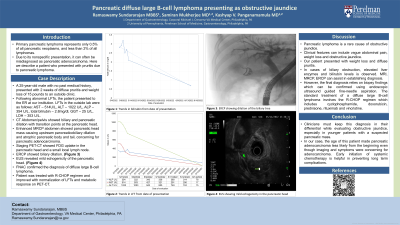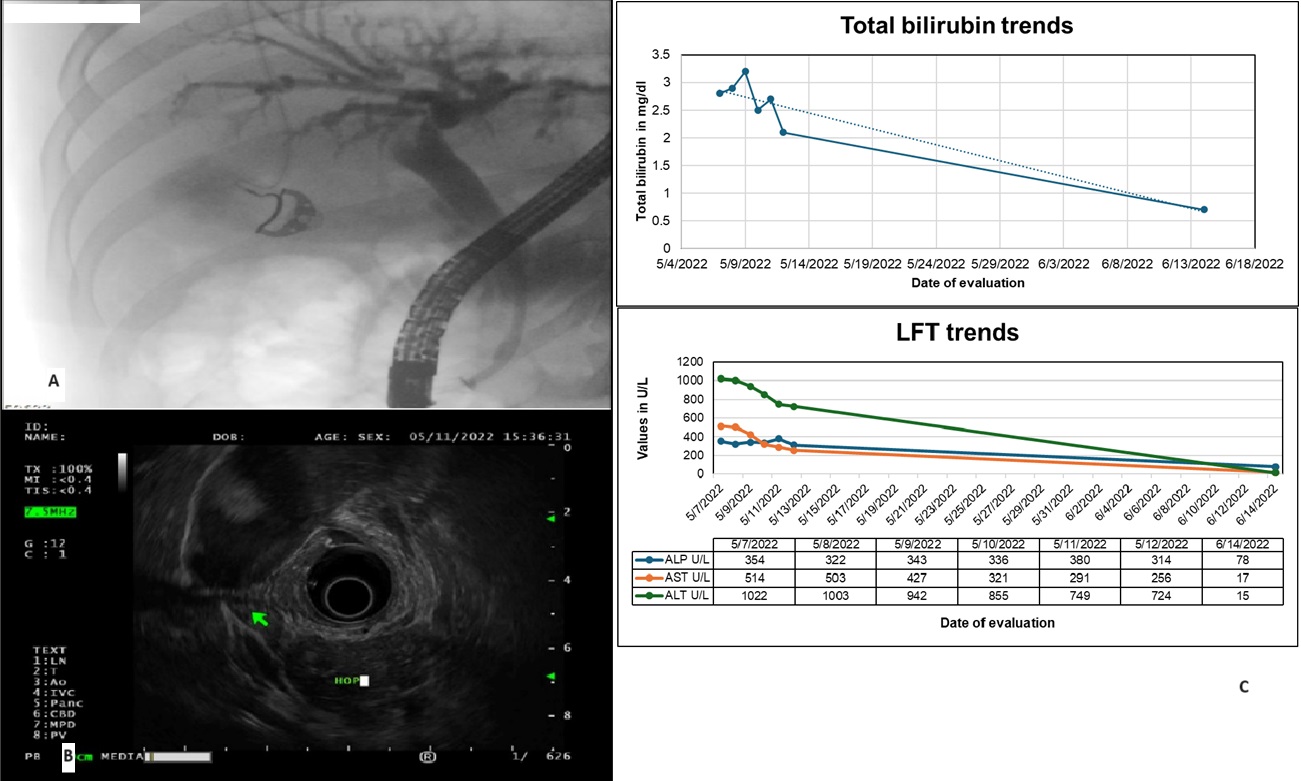Sunday Poster Session
Category: Biliary/Pancreas
P0197 - Pancreatic Diffuse Large B-cell Lymphoma Presenting as Obstructive Jaundice
Sunday, October 27, 2024
3:30 PM - 7:00 PM ET
Location: Exhibit Hall E

Has Audio

Ramaswamy Sundararajan, MBBS
Corporal Michael J. Crescenz VA Medical Center
Philadelphia, PA
Presenting Author(s)
Ramaswamy Sundararajan, MBBS1, Samiran Mukherjee, MD2, Kashyap V. Panganamamula, MD2
1Corporal Michael J. Crescenz VA Medical Center, Philadelphia, PA; 2Perelman School of Medicine at the University of Pennsylvania, Philadelphia, PA
Introduction: Primary pancreatic lymphoma represents only 0.5% of all pancreatic neoplasms, and less than 2% of all lymphomas. 1,2 Due to its nonspecific presentation, it can often be misdiagnosed as pancreatic adenocarcinoma. Here we describe a patient who presented with pruritis due to pancreatic lymphoma.
Case Description/Methods: A 25-year-old male with no past medical history, presented with 2 weeks of diffuse pruritis and weight loss of 15 pounds to an outside clinic. Following abnormal LFTs, the patient presented to the emergency department at our institution. LFTs in the outside lab were as follows: AST – 514U/L, ALT – 1022 U/L, ALP – 354 U/L, total bilirubin – 2.8mg/dl, GGT – 25 U/L, LDH – 353 U/L.
CT Abdomen/pelvis showed biliary and pancreatic dilation with transition points at the pancreatic head. Enhanced MR-MRCP abdomen showed pancreatic head mass causing upstream pancreaticobiliary dilation and atrophic pancreatic body and tail, concerning for pancreatic adenocarcinoma. Staging PET-CT showed FDG uptake in the pancreatic head and a small local lymph node. ERCP showed biliary dilation. EUS revealed mild echogenicity of the pancreatic head. FNAC confirmed the diagnosis of diffuse large B-cell lymphoma. Patient was treated with R-CHOP regimen and improved with normalization of LFTSs and metabolic response on PET-CT.
Discussion: Pancreatic lymphoma is a rare cause of obstructive jaundice. Clinical features can include vague abdominal pain, weight loss and obstructive jaundice. 3,4 In cases of biliary obstruction, elevated liver enzymes and bilirubin levels is observed. MRI, MRCP, ERCP can assist in establishing diagnosis. However, the final diagnosis relies on biopsy findings which can be confirmed using endoscopic ultrasound guided fine-needle aspiration. The standard treatment of a diffuse large B-cell lymphoma involves the R-CHOP regimen which includes cyclophosphamide, doxorubicin, prednisone, rituximab and vincristine.
Clinicians must keep this diagnosis in their differential while evaluating obstructive jaundice, especially in younger patients with a suspected pancreatic mass. In our case, the age of this patient made pancreatic adenocarcinoma less likely from the beginning even though imaging and symptoms were concerning for adenocarcinoma. Early initiation of systemic chemotherapy is helpful in preventing long term complications.5

Disclosures:
Ramaswamy Sundararajan, MBBS1, Samiran Mukherjee, MD2, Kashyap V. Panganamamula, MD2. P0197 - Pancreatic Diffuse Large B-cell Lymphoma Presenting as Obstructive Jaundice, ACG 2024 Annual Scientific Meeting Abstracts. Philadelphia, PA: American College of Gastroenterology.
1Corporal Michael J. Crescenz VA Medical Center, Philadelphia, PA; 2Perelman School of Medicine at the University of Pennsylvania, Philadelphia, PA
Introduction: Primary pancreatic lymphoma represents only 0.5% of all pancreatic neoplasms, and less than 2% of all lymphomas. 1,2 Due to its nonspecific presentation, it can often be misdiagnosed as pancreatic adenocarcinoma. Here we describe a patient who presented with pruritis due to pancreatic lymphoma.
Case Description/Methods: A 25-year-old male with no past medical history, presented with 2 weeks of diffuse pruritis and weight loss of 15 pounds to an outside clinic. Following abnormal LFTs, the patient presented to the emergency department at our institution. LFTs in the outside lab were as follows: AST – 514U/L, ALT – 1022 U/L, ALP – 354 U/L, total bilirubin – 2.8mg/dl, GGT – 25 U/L, LDH – 353 U/L.
CT Abdomen/pelvis showed biliary and pancreatic dilation with transition points at the pancreatic head. Enhanced MR-MRCP abdomen showed pancreatic head mass causing upstream pancreaticobiliary dilation and atrophic pancreatic body and tail, concerning for pancreatic adenocarcinoma. Staging PET-CT showed FDG uptake in the pancreatic head and a small local lymph node. ERCP showed biliary dilation. EUS revealed mild echogenicity of the pancreatic head. FNAC confirmed the diagnosis of diffuse large B-cell lymphoma. Patient was treated with R-CHOP regimen and improved with normalization of LFTSs and metabolic response on PET-CT.
Discussion: Pancreatic lymphoma is a rare cause of obstructive jaundice. Clinical features can include vague abdominal pain, weight loss and obstructive jaundice. 3,4 In cases of biliary obstruction, elevated liver enzymes and bilirubin levels is observed. MRI, MRCP, ERCP can assist in establishing diagnosis. However, the final diagnosis relies on biopsy findings which can be confirmed using endoscopic ultrasound guided fine-needle aspiration. The standard treatment of a diffuse large B-cell lymphoma involves the R-CHOP regimen which includes cyclophosphamide, doxorubicin, prednisone, rituximab and vincristine.
Clinicians must keep this diagnosis in their differential while evaluating obstructive jaundice, especially in younger patients with a suspected pancreatic mass. In our case, the age of this patient made pancreatic adenocarcinoma less likely from the beginning even though imaging and symptoms were concerning for adenocarcinoma. Early initiation of systemic chemotherapy is helpful in preventing long term complications.5

Figure: Figure A – ERCP showing dilatation of the biliary tree
Figure B – EUS showing mild echogenicity in the pancreatic head
Figure C – Trends in total bilirubin and LFTs from date of presentation
Figure B – EUS showing mild echogenicity in the pancreatic head
Figure C – Trends in total bilirubin and LFTs from date of presentation
Disclosures:
Ramaswamy Sundararajan indicated no relevant financial relationships.
Samiran Mukherjee indicated no relevant financial relationships.
Kashyap V. Panganamamula indicated no relevant financial relationships.
Ramaswamy Sundararajan, MBBS1, Samiran Mukherjee, MD2, Kashyap V. Panganamamula, MD2. P0197 - Pancreatic Diffuse Large B-cell Lymphoma Presenting as Obstructive Jaundice, ACG 2024 Annual Scientific Meeting Abstracts. Philadelphia, PA: American College of Gastroenterology.
